

The night of 28th May 2005 was a most interesting night to
observe Jupiter and the four Galilean satellites. The pictures below are in chronological
order and I've indicated the interesting events in the commentary beside each image.
I've never seen all four of these satellites so close to Jupiter before. Callisto seems to be in a very
strange place below the south pole. The reason is that the Earth is well south of the plane of the orbits
and Callisto is on the far side of its orbit. Callisto is the furthest from Jupiter and it is far enough
away that we can see it past the disc of Jupiter.
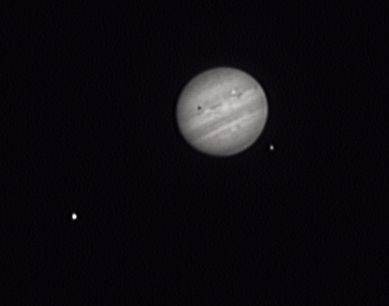 |
This is the first picture, taken only 30 minutes after sunset when the sky was still very bright. It
was taken with infra-red light, which not only is scattered less by our atmosphere but also shows the satellites
and some surface features more clearly than visible light. Three of the satellites are visible. Io
is in transit (the white dot) and is casting a shadow (the black dot) onto the planet's clouds; Europa
is invisible because it was being eclipsed by Jupiter. Callisto appears in a strange position below the
south pole of Jupiter. Move your mouse over the image to see the satellites identified. Date and Time: 28th May 2005 20:36 UT Camera: ToUcam 740K Telescope: LX200 at prime focus Capture: K3CCDTools. High gamma, 1/25", 60% gain, 421 frames Processing: Registax. 171 frames stacked. Wavelets 1-3 = 10, gamma 0.6 |
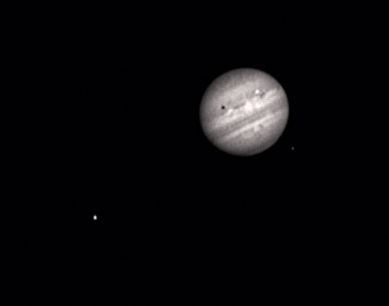 |
This picture was taken only a couple of minutes after the one above but with a low gamma setting on the camera.
This brings out the detail on the planet a little more clearly, but reduces the contrast of the satellites,
so Callisto has almost disappeared. Move your mouse over the image to see the satellites identified. Date and Time: 28th May 2005 20:39 UT Camera: ToUcam 740K Telescope: LX200 at prime focus Capture: K3CCDTools. Low gamma, 1/25", 60% gain, 480 frames Processing: Registax. 288 frames stacked. Wavelets 1-3 = 10, contrast 120 |
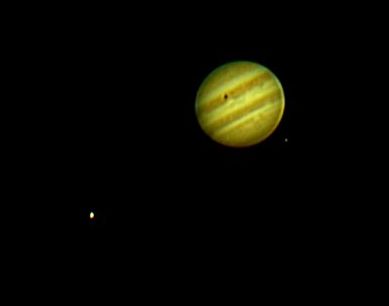
|
This picture was taken about ten minutes after the one above but using visible light.
Even with a high setting of gamma on the camera, the satellites do not stand
out as well as they did in the infra-red; I can't see Io, and Callisto is very faint.
However we can see the colours in the bands of Jupiter.
Date and Time: 28th May 2005 20:49 UT Camera: ToUcam 740K Telescope: LX200 at prime focus Capture: K3CCDTools. High gamma, 1/100", 33% gain, 434 frames Processing: Registax. 204 frames stacked. Wavelets 1-3 = 10, gamma 0.6, contrast 120, brightness -40. |
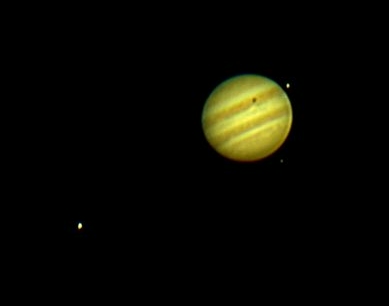
|
This picture was taken about 34 minutes later. Io has ended its transit and is now
clearly visible to the right of the planet, and you may be able to see that Callisto has moved
a little to the left. But Europa is still in eclipse.
Date and Time: 28th May 2005 21:23 UT Camera: ToUcam 740K Telescope: LX200 at prime focus Capture: K3CCDTools. High gamma, 1/100", 33% gain, 402 frames Processing: Registax. 191 frames stacked. Wavelets 1-3 = 10, gamma 0.6, contrast 120, brightness -32. |
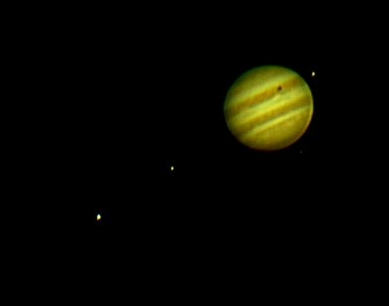 |
And here, in a picture taken about 7 minutes later, Europa has appeared having emerged from eclipse
a minute of so before. The mouseover picture has had its gamma increased to 2.0 in order to
bring out Callisto which may not be visible in the base picture.
Date and Time: 28th May 2005 21:30 UT Camera: ToUcam 740K Telescope: LX200 at prime focus Capture: K3CCDTools. High gamma, 1/100", 38% gain, 414 frames Processing: Registax. 182 frames stacked. Wavelets 1-3 = 10, gamma 0.5, histogram 50-255. |
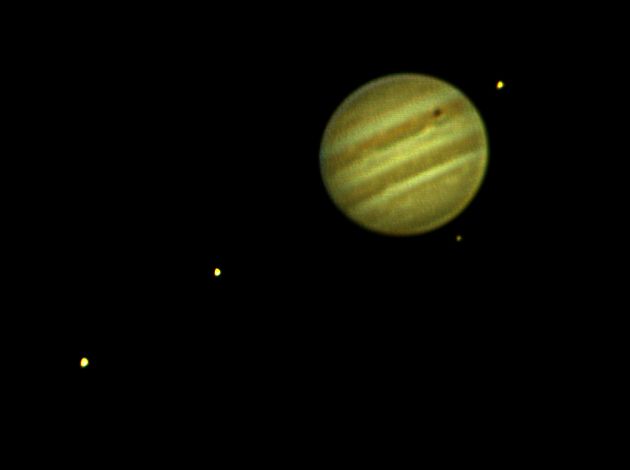 |
Now a close-up picture taken with my X2 SLR adaptor lens. Never before have I been able to capture all
four satellites in a single frame at this focal length (~5000 mm).
Date and Time: 28th May 2005 21:42 UT Camera: ToUcam 740K Telescope: LX200 with X2 SLR adaptor Capture: K3CCDTools. High gamma, 1/33", 25% gain, 406 frames Processing: Registax. 65 frames stacked. Wavelets 1-6 = 10, colours realigned PhotoImpact. Unsharp mask factor 50, aperture 2 pixels. |
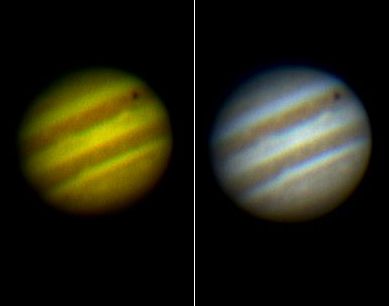
|
And finally two pictures taken a couple of minutes apart. The difference is that the colour balance
of the camera was slightly different. On the left the balance is as it was in the earlier pictures,
whilst on the right the blue has been increase very slightly. Which colours are correct I do not know.
Date and Time: 28th May 2005 21:52 and 21:56 UT Camera: ToUcam 740K Telescope: LX200 with X2 SLR adaptor Capture: K3CCDTools. Low gamma, 1/100", 30% and 19% gain, 411 and 455 frames Processing: Registax. 199 and 254 frames stacked. Wavelets 1-3 = 10, gamma 0.7 and 0.8, contrast 105 with brightness -30, and contrast 165. |
Home Back to Jupiter